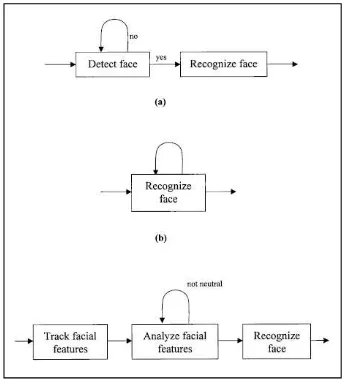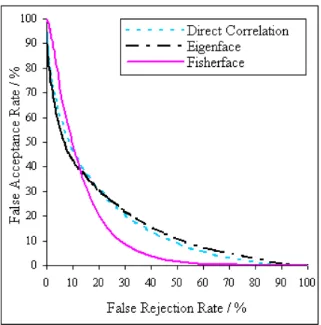HUMAN FACE RECOGNITION SYSTEM
Tinesh A/L Subramanian
I hereby declare that I have read through this report entitle “Human Face Recognition System” and found that it has comply the partial fulfillment for awarding the degree of Bachelor of Mechatronics Engineering.
Signature : ……….
Supervisor’s Name : ……….
HUMAN FACE RECOGNITION SYSTEM
TINESH A/L SUBRAMANIAN
A report submitted in partial fulfillment of the requirement for the degree of Bachelor of Mechatronics Engineering
Faculty of Electrical Engineering
I declare that this report entitle “title of the project” is the result of my own research except as cited in the references. The report has not been accepted for any degree and is not concurrently submitted in candidature of candidature of any other degree.
Signature : ……….
Name : ……….
ACKNOWLEDGEMENT
ABSTRACT
ABSTRAK
TABLE OF CONTENTS
CHAPTER TITLE PAGE
ACKNOWLEDGEMENT
ABSTRACT
TABLE OF CONTENTS
LIST OF TABLES
LIST OF FIGURES
II
III
V
VIII
IX
1 INTRODUCTION
1.1.Project Background 1.2.Problem Statement 1.3.Objectives
1.4.Scope
1.5.Expected Output 1.6.Conclusion 1 1 2 3 3 4 4
2 LITERATURE REVIEW
5.1.Introduction
5.3.Analysis 2.3.1. Limitation 2.3.2. Comparisons 5.4. Conclusions 9 9 10 12
3 METHODOLOGY
3.1. Face Recognition Flowchart 3.2. Algorithms
3.2.1. Stage 1: Converting Color Image To Grayscale Image 3.2.2. Stage 2: Prepare The Data
3.2.3. Stage 3: Subtract The Mean
3.2.4. Stage 4: Calculate The Covariance Matrix
3.2.5. Stage 5: Eigenface Calculation Principal Component Analysis
3.2.6. Stage 6: Calculation Of Eigenvalue And Eigenvector 3.2.7. Stage 7: Choosing Components And Forming A
Feature Vector
3.2.8. Stage 8: Built Graphical User Interface 3.3. Conclusions 13 15 16 16 17 17 17 18 19 20 21 23
4 RESULT
4.1. Introduction
4.2. Experimental Setup
4.2.1. Matlab Installation
4.2.1.1. Step 1: Start The Installer
4.2.1.2. Step 2: Enter Your Personal License Password (PLP)
4.2.1.3. Step 3: Review The Software Licensing Agreement
4.2.1.4. Step 4: Enter Name And Company Name 4.2.1.5. Step 5: Select The Products Want To Install
4.2.1.7. Step 7: Complete The Installation 4.2.2. MATLAB Software
4.3. Formula 4.4. Algorithms 4.5. Programming
4.6. Graphical User Interface 4.7. Conclusions 30 31 35 37 42 43 49
5 DISCUSSION OF RESULTS
5.1. Introduction
5.2. Principal Components Analysis 5.3. Image Representation
5.4. Image Patterns 5.5. Image Compression 5.6. Threshold 5.7. Conclusions 50 50 50 51 52 52 53 56
6 SUMMARY AND CONCLUSION
LIST OF TABLES
TABLE TITLE PAGE
5.1 5.2
Sample Data for 3 Persons Statistic Data for 3 Persons
LIST OF FIGURES
FIGURE TITLE PAGE
2.1 2.2 3.1 3.2 3.3 3.4 4.1 4.2 4.3 4.4 4.5 4.6 4.7 4.8 4.9 4.10 4.11 4.12 4.13 4.14 4.15
Typical approaches to face recognition
Comparison performance based on approaches Project Flowchart
Face Recognition System Algorithms Flowchart Example of Eigenfaces
Designing A Graphical User Interface Welcome Dialog Box
PLP Dialog Box Product List
Product Configuration Notes Installation Complete
MATLAB Interface M-file Interface GUI Interface Input Dialog Box Message Box and Icons
Test Procedure for Face Recognition System Algorithms for Select and Read an Image Add Image to Database
Algorithm for Create New Database Algorithm for Delete Database
4.17 4.18 4.19 4.20 4.21 4.22 4.23 4.24 4.25 4.26 4.27 4.28 4.29 4.30 4.31 5.1
Algorithms for Eigenvalues and Covariance Matrix Algorithm for Face Space Projection
Algorithm for Euclidian Distance Measurement Select Image
Image Selected Input Image Warning Database Created Database Results Class Results
Delete Database Question Database Removed Database Warning Recognition Warning Unknown Face Non- Face Warning Efficiency of Threshold
CHAPTER I
INTRODUCTION
1.1 Project Background
Human face recognition system is a security system which will be developed to classify and recognize human face as a password to get access to the system. It is system where an organization can use it as security system to their authority room access. This system only requires a wireless camera and workstation which installed with MATLAB software to operate it. This wireless camera will be used to capture human faces. Then, the receiver of this camera which connected to a workstation will transmit the data from the camera to workstation.
1.2 Problem Statement
Identification card checking to recognize human is become less secure. A lot of fraudulence methods are used to create duplicate cards to breakthrough authority checking. A biometric authentication will help solve the problem. Therefore, proposed project is to develop the human face recognition system that is able to classify and recognize human face securely compared using identification card.
Although it is more secure, there are lot problems in implementing this system. In order to test and train the system, data set contains number of human faces are needed. The main problem is data set which will be created using wireless camera will not surely satisfy the standard orientation of the system needs. Let says the face captured is not at center of the camera, there will be difficulty in processing that particular image.
The objective of this project is to:
i. Develop algorithm to detect human face and classify it by computing its eigenvectors and eigenvalues
ii. Develop algorithm to recognize human face and its Class iii. Create Training Set Data for the Face Recognition System
iv. Build up a Graphical User Interface (GUI) for the Face Recognition System v. Build up a face Recognition System using any Integrated Development
Environment (IDE)
1.4 Scope
The face recognition system algorithm will be developed by analyze the famous algorithms from pattern recognition algorithms. The computational approach algorithm was identified give satisfactory results. This type of algorithms approach will extract out eigenvalues and eigenvectors from the image. This will need spaces to store the data. So, the MATLAB workspace will be utilized by create appropriate algorithms.
1.5 Expected Output
These face recognition system will detect human faces and categorize it by computing the eigenvectors and eigenvalues. Different reference value (eigenvectors and eigenvalues) will be created for each person and stored it for further process. Then, algorithms will be developed to recognize human face and figure it out from the data set. The algorithms consist of mathematical calculation and programming will be used to process the input image.
Next, data set will be built for face recognition system will consists group of human faces which collected to test and train the system. In addition, Graphical User Interface (GUI) also will be developed. GUI is developed to easier the user to discover the system process such as image being processed and result of the process. The face recognition system is a complicated process. So, MATLAB software will be used as platform to develop this system.
1.6 Conclusion
CHAPTER II
LITERATURE REVIEW
2.1 Introduction
Biometrics refers to methods for uniquely recognizing humans based upon one or more intrinsic physical or behavioral traits. Biometric characteristics can be divided in two main classes that are physiological and behavioral. Physiological are related to the shape of the body but are not limited to fingerprint, face recognition, DNA, hand and palm geometry, iris recognition, which has largely replaced retina, and odor/scent. Behavioral are related to the behavior of a person but are not limited to typing rhythm, gait, and voice. Some researchers have coined the term behaviometrics for this class of biometrics.
Biometric authentication normally used in national ID cards, airport security, surveillance, site access and so on. But, face recognition offers several advantages over other biometrics as listed below:-
i. Covert operation or can be used without subjects knowledge ii. Human readable media
Actually, this biometric face recognition system is divided into two major parts that is "Face Identification" and "Face Recognition". But, only recognition part only will be covered. Below are some typical approaches which used in face recognition. [1]
Figure 2.1: Typical approaches to face recognition
There are several techniques famously used by worldwide experts for commercial and R&D purpose. The commercialization of face recognition still fewer compare other biometric security system such as iris and thumb scanning. But, at R&D are actively searching new face recognition technology since it believed have tendency to develop near future. [1]
There are several methods which famously discussed under research. There are Direct Correlation, Eigenfaces and Fisherfaces. Every of them seem using almost same way in development of techniques but actually it's not. Because their way of stored the image into database may seems same. But, the ways it recognize the new image are vary via different methods. They have their own advantages and disadvantages as described in following section.
2.2.1 Direct Correlation
2.2.2 Eigenfaces
Eigenfaces are a set of eigenvectors used in computer vision problem of human face recognition. The approaches of using eigenfaces for recognition was developed and used in face pattern classification. These eigenvectors are derived from the covariance matrix of the probability distribution of the high-dimensional vector space of possible faces of human beings. To generate a set of eigenfaces, a large set of digitized images of human faces are taken under the same lighting conditions and normalized to line up the eyes and mouths. Mathematical tool as Principal Component Analysis (PCA) is used to extract out the image data. [2]
2.2.3 Fisherfaces
According to study on related topics, limitations are discovered for face recognition system. The limitation are depends on environment of the image captured and developed algorithms. Then, comparisons of effectiveness are done within explained face recognition approaches.
2.3.1 Limitation
Developed face recognition system effectiveness is highly dependent on image capture. But there are some limitations for the system. Variations of lighting condition are highly effect the brightness of the image and different lighting condition for enrolment and query. This will cause the image saturation which difficult to differentiate the face from the background. Then, the pose of head orientation should be standardized. The 2D feature distances appear to distort if angle of head turning vary much since we need to calculate Euclidian distance.
Even the best algorithms is developed, the factors such as shown above are always reduce performance of the system. So, in order to increase the accuracy of the developed face recognition system controlled environment such as under steady lighting condition, fixed head orientation and face expression when posing should be carried out. [5]
2.3.2 Comparisons
Figure 2.2: Comparison performance based on approaches

